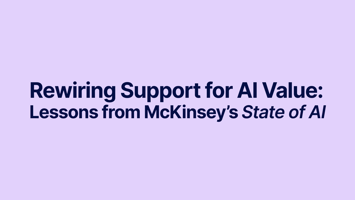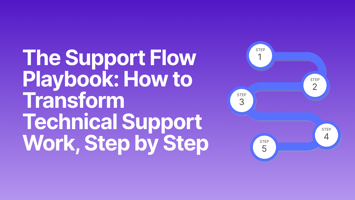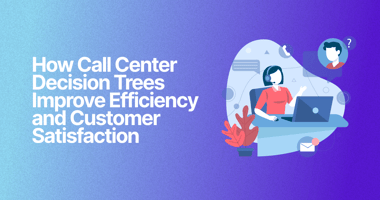McKinsey’s 2025 State of AI survey has one message support leaders can’t ignore: AI only creates...
The Power of Decision Trees in Enterprise Support

How Guided Decision Trees Cut Handle Time and Boost Customer Satisfaction
In today’s fast-paced enterprise environments, customer support teams face immense pressure to resolve issues quickly and effectively. With growing ticket volumes and increasingly complex inquiries, support leaders need solutions that streamline workflows, enhance decision-making, and improve customer experiences. One of the most effective tools for achieving this is the guided decision tree—an interactive framework that helps support agents navigate customer issues efficiently and consistently.
By implementing guided decision trees, enterprise support teams can significantly improve key performance metrics like Average Handle Time (AHT), First-Contact Resolution (FCR), and overall customer satisfaction (CSAT). Let’s explore how decision trees work, why they’re crucial in support environments, and how tools like PixieBrix make them easy to deploy at scale.
What Are Decision Trees in Enterprise Support?
A decision tree is a structured guide that helps support agents and customers navigate troubleshooting steps, policy questions, or escalation paths. It presents a series of predefined questions and actions, ensuring a logical, step-by-step process for resolving issues. Think of it as a dynamic flowchart that removes guesswork from support interactions.
Unlike static scripts or knowledge base articles, guided decision trees adapt based on user input, presenting relevant next steps in real time. This not only accelerates resolutions but also ensures consistency across agents—no matter their experience level.
Key Benefits of Decision Trees in Support Workflows:
-
Faster Issue Resolution: Agents follow an optimized path, reducing time spent troubleshooting.
-
Higher First-Contact Resolution (FCR): Customers get the right answers without needing multiple interactions.
-
Improved Consistency: Every agent follows the same structured approach, reducing errors.
-
Better Customer Experience: Faster, more accurate resolutions lead to higher satisfaction and loyalty.
How Decision Trees Improve Key Support Metrics
1. Reducing Average Handle Time (AHT)
AHT measures the total time an agent spends handling a support interaction, including talk time, hold time, and after-call work. The longer the AHT, the higher the cost per resolution—and the more customers are left waiting for assistance.
Decision trees help reduce AHT by:
-
Eliminating unnecessary steps and guiding agents directly to the best solution.
-
Presenting relevant troubleshooting paths based on real-time inputs.
-
Reducing the need for hold time or supervisor escalations by providing immediate, structured guidance.
💡 Case Study: After implementing guided decision trees, a leading enterprise helpdesk cut its AHT by 40%, allowing agents to handle more tickets per hour without compromising quality.
2. Increasing First-Contact Resolution (FCR)
FCR measures the percentage of customer issues resolved during the first interaction without requiring follow-ups. High FCR rates indicate efficient troubleshooting and better customer satisfaction.
Decision trees improve FCR by:
-
Ensuring agents ask the right questions upfront, eliminating unnecessary back-and-forth.
-
Providing real-time access to knowledge base articles and contextual insights.
-
Offering dynamic decision-making paths that adjust based on customer responses.
💡 Industry Insight: Companies with structured decision trees report up to a 30% increase in FCR, reducing the burden on escalations and callbacks.
3. Enhancing Customer Satisfaction (CSAT)
CSAT is directly tied to response speed, accuracy, and agent confidence. Customers expect quick, precise resolutions—and decision trees empower agents to meet those expectations.
By guiding agents through accurate troubleshooting flows, decision trees:
-
Reduce frustration from misdiagnoses and incorrect resolutions.
-
Ensure consistent service quality, regardless of agent expertise.
-
Improve customer perception of the brand by providing a seamless support experience.
💡 Example: A global telecom provider using decision trees for customer support saw a 25% increase in CSAT within six months, driven by faster response times and improved issue resolution accuracy.
Deploying Decision Trees with PixieBrix
Implementing decision trees can be complex—especially at the enterprise level, where workflows, policies, and integrations vary across teams. This is where PixieBrix comes in.
PixieBrix enables teams to build, customize, and deploy decision trees seamlessly, without needing developers. Its browser-based, no-code interface allows operations and support teams to design interactive decision trees that integrate directly into existing tools like Zendesk, Salesforce, and ServiceNow.
Key Features of PixieBrix Decision Trees:
✅ No-Code Customization: Build and modify decision trees visually—no IT expertise required.
✅ Seamless Integration: Deploy decision trees on top of any web-based application.
✅ Real-Time Agent Guidance: Embed interactive workflows directly into agent dashboards.
✅ AI-Powered Recommendations: Enhance decision trees with AI-driven suggestions for faster resolutions.
Example Use Case: A multinational retail company used PixieBrix to create guided decision trees for handling customer refunds, product troubleshooting, and escalations. The result? 20% faster ticket resolution and a 15% improvement in agent efficiency.
The Future of Enterprise Support: Smarter, AI-Enhanced Decision Trees
As AI and automation continue to shape enterprise support, decision trees will become even more sophisticated. Future enhancements will include:
-
AI-Powered Decision Trees: Automating decision paths based on past resolution patterns.
-
Self-Learning Systems: Dynamic decision trees that improve over time based on real-world interactions.
-
Predictive Support Models: Using AI to anticipate issues and recommend proactive solutions before they escalate.
By adopting guided decision trees today, enterprises can lay the foundation for a more efficient, intelligent, and customer-centric support experience.


